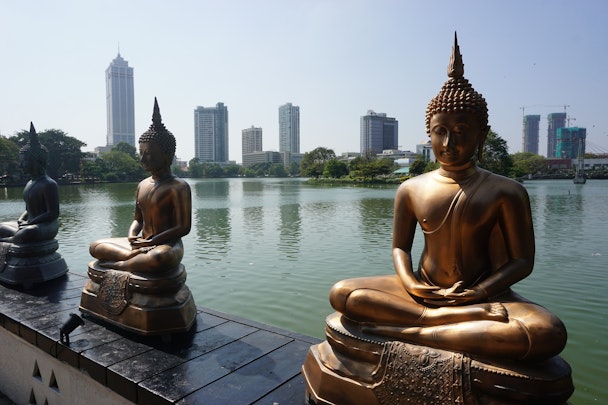State of the Nation: Decoding 'Sri Lanka' beyond cricket, curries and the civil war
Global brands wishing to gain a footprint in the Sri Lankan market need to adopt a ‘thoughtful marketing’ approach and understand the sentiments of local consumers. In the latest State of Nation, Sandeep Dutta, vice president (insights division) at Kantar Group, reveals the elements that create the unique Sri Lankan consumer.

Sri Lanka's local brands are successfully taking on major international brands / Image by Andromachos Dimitrokallis from Pixabay
What are you likely to find in British supermodel Naomi Campbell’s Fendi bag? Amongst other things is a pack of Samahan, the magical herbal tea sachets from Sri Lanka that have gained immense popularity across the globe in recent years. Dilmah, arguably Sri Lanka’s most familiar tea brand outside the island nation, is now rubbing shoulders with Starbuck cafes in Malaysia. Spa Ceylon, a homegrown luxurious ayurvedic personal care brand is available in countries as diverse as Switzerland and Korea.
Very quietly but effectively, brands from Sri Lanka, lovingly called the pearl of the Indian Ocean, are making their presence felt across the world with offerings that reflect its rich natural resources. It is a country known for its pristine beaches, friendly people, spicy curries, clean cities (Sri Lanka can easily boast of being one of the cleanest countries in South Asia) and cricket and in recent times the economic crisis which unfortunately is the cause of a lot of trouble at the moment.
But that should not undermine the success stories of local brands in Sri Lanka. For a small country (with a population of 22 million in 2020 it is one of the smallest countries in Asia), Sri Lanka has the audacity to take on global FMCG brands and give them a run for their money in the local market.
Hugely popular local brands like Prima Kottu mee (instant noodles), Clogard (toothpaste), Elephant House Cream Soda (bottled cold beverage) and Diva (detergent) are giving globally iconic brands like Maggi, Signal, Coca-Cola and Sunlight, respectively, keen competition.
Thoughtful marketing that reflects a deep understanding of the sentiments of Sri Lankan consumers and the high-quality standards of the local brands empowers them to stand up against international giants.
In categories like packaged snacks, frozen food and personal care, local brands rule the roost with a wide range of products at different price points. Global brands planning to enter these spaces have to be well prepared to face stiff competition from the local powerhouse brands.

There are other things that one has to be careful about. Given its proximity to India, there is a tendency among marketers to view Sri Lanka as an extension of India and treat it as its ‘first cousin’. But, unfortunately, that does not always work. Though the two neighbouring nations are not like chalk and cheese, they do have their differences which need to be acknowledged and respected.
A few characteristics of Sri Lankans, that make them stand out in the Indian sub-continent are:
Sri Lankans are liberal and their lifestyles have considerable western influence. This reflects in myriad ways that include clothing (urban women can be seen in the most stylish western attire in public spaces), food choices (Sri Lankans not only love their rice and curries but can be seen devouring tea buns, puffs and assorted cakes in roadside bakeries) and festivals (though largely a Buddhist country, Christmas is celebrated in the truest of spirits with a lot of fervour and style).
Sri Lanka doesn't have the crippling poverty or overpopulation of India/Pakistan/Bangladesh. The divide between urban and rural or rich and poor is not as sharp as it is found in the Indian subcontinent and even the underprivileged can be seen living in decent dwellings, shopping in large supermarkets and taking care of themselves with the support of the country’s strong primary healthcare system. As a consumer, the rural consumer is almost as exposed and discerning as her urban counterpart which makes the Sri Lankan market quite homogeneous and unlike India does not require a distinctly different strategy for urban and rural sectors.
Sri Lanka won its independence from the UK in 1948 and enshrined the right to free education in the constitution some years later. Despite the ravages of the long-drawn civil war, the country maintains some of the highest literacy rates in South Asia among both men and women ( 92% in 2020). The women of Sri Lanka are knowledgeable, and progressive and tend to be the key decision maker for most purchases and expect brands to acknowledge their position in society.
Lastly, it’s the people of Sri Lanka who though strongly collectivist and believing in ‘family first’ like the rest of the people in the Indian sub-continent, are more fun-loving and free-spirited than them (albeit being a bit too laid back at times!).
However, beneath their ‘easygoing’ demeanour lies a highly resilient attitude that helped them to recover swiftly from the wreck of the Civil war. The country is now declared bankrupt but the people haven’t given up hope and expect that sooner than later they will emerge from these troubled times and continue to live happily on this beautiful and sunny island of theirs.
Sandeep Dutta is the vice president (insights division) at Kantar Group.

